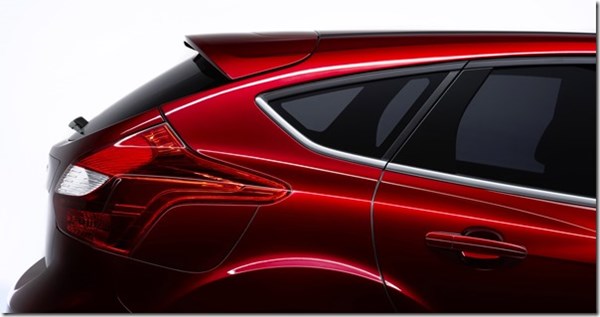2014 Ford Focus Titanium
So, what is the biggest selling nameplate in the world?
#marketing #electronics #interior
So, what is the biggest selling nameplate in the world? Is it the Toyota Corolla (and the cars that are Corolla that happen to have another name but are still Corollas)? Or is it the Ford Focus (and a Focus is a Focus is a Focus--worldwide)?
Here’s another question related to that: Who cares?
(This, of course, assumes that you aren’t in Ford or Toyota marketing. And apparently the answer is Focus.)

If you are buying a car, do you really care if someone on the other side of the planet has one just like yours? That might be a disincentive to buy it. Seriously: you go on vacation to some far off place, and there’s someone wearing the same Nikes that you have on your feet climbing into a car that is exactly like the one you left in the long-term lot at the airport back home.
It is, of course, all about bragging rights for the companies in question.
But in the case of the Focus, certainly, there is another advantage. It’s this: the U.S. market now has the Focus that people in other parts of the world have had, and that Focus was a really, really good Focus. A lot of that has to do with the fact that in other parts of the world they don’t have big cars like the Taurus or big trucks like the F-150. For a number of years (and sadly it seems that that number has grown all too large) Ford had a focus on the Taurus and made sure they were making it a competitive and desirable car. And then there were the pickups that are so important to the Ford brand. In addition to which, there was the whole sport utility phenomenon that was a key element in the Ford U.S. strategy.
But times have changed, and compact cars are crucial.
So from the sheet metal in, the current generation Focus that is on the highways and byways of the U.S. (and in all those other countries) is designed and engineered at higher levels than was the case when it wasn’t as important a car.

One of the things that strikes me about how much care was taken in developing the Focus is something that you’ll use numerous times throughout the period of time you own the car yet is something that you probably don’t necessarily think a whole lot about.
It’s the fuel-filler door. Generally, these doors are square or round. A whole is punched in a rear quarter panel and the door is affixed. It’s almost a “who cares”? (This is not to be dismissive of those who have to design and engineer the doors, because there is more to it than this cursory description gives it.)
Check out the fuel filler door on the Focus—assuming that you can find it. It is cleverly designed into the right rear quarter panel. It has a shape closely akin to a diamond. It is positioned on an angle.
It is not something that is simply there. It is deliberate. Conscious.
You can tell a lot about a car by the little things. And the design of that door says a tremendous amount about the Focus.
Mind you, this doesn’t come without a price. The base price for this Focus, which has the top trim Titanium level, is $24,115. Yes, a compact car. The options (e.g., special paint, navigation package) add $1,190. And as you also need to pay delivery--$795—you’re looking at a sticker that says “Total MSRP $26,100.”
Yes, a compact car.
So a question is: Is it worth it?
I think so.

It’s got the goods, like leather-trimmed front seats, pushbutton staring, Sony audio and Sync with MyFordTouch (that worked as planned, so know that not all systems are somehow plagued). It has a 2.0-liter gasoline direct-injected engine and a six-speed automatic transmission. It is roomy for a compact, and while some might think that the hatchback version—which has an exterior design that is far more appealing than the sedan—might be a bit space-constrained compared to the sedan, the interior dimensions for humans in both versions are identical, with the exception of the hatch giving up 0.1-in. in rear headroom to the sedan (37.9 in. vs. 38 in.). Stuff-wise, the space behind the second row of the hatch is 23.8 cu. ft.; the trunk in the sedan is 13.2 cu. ft.
But it is not a cheap car. But importantly, it is not cheap in both senses of the word: It is not inexpensive. It is not shoddily made. Arguably, it is world class.
Selected specs
Engine: 2.0-liter Ti-VCT, FFV I4
Horsepower: 160 @ 6,500 rpm
Torque: 146 lb-ft @ 4,450 rpm
Materials: Aluminum block and head
Transmission: Six-speed automatic
Steering: Rack and pinion with EPAS
Wheelbase: 104.3 in.
Length: 171.6 in.
Width: 71.8 in.
Height: 57.7 in.
Curb weight: 2.948 lb.
EPA: 26/37/30 mpg city/highway/combined
RELATED CONTENT
-
Rivian Gets Even More Money, Now From Ford
The electrification of automotive is serious business. This week it was announced that Ford is making a $500-million equity investment in Rivian.
-
Electric Motors for Aero and Auto
Rolls-Royce—the manufacturer of aircraft engines, not the one that makes high-end vehicles with four wheels—is working with another British company, YASA, on the development of the ACCEL, an electric airplane.
-
2017 Mazda MX-5 Club RF
The Mazda slogan “Driving Matters” pretty much sums up the 2017 MX-5 Miata Club RF.


.jpg;width=70;height=70;mode=crop)